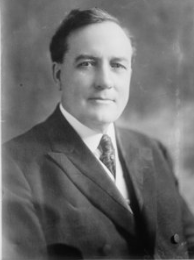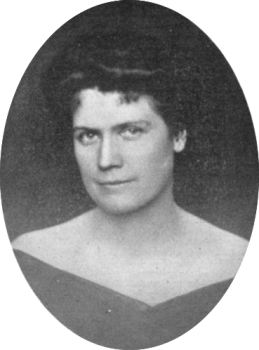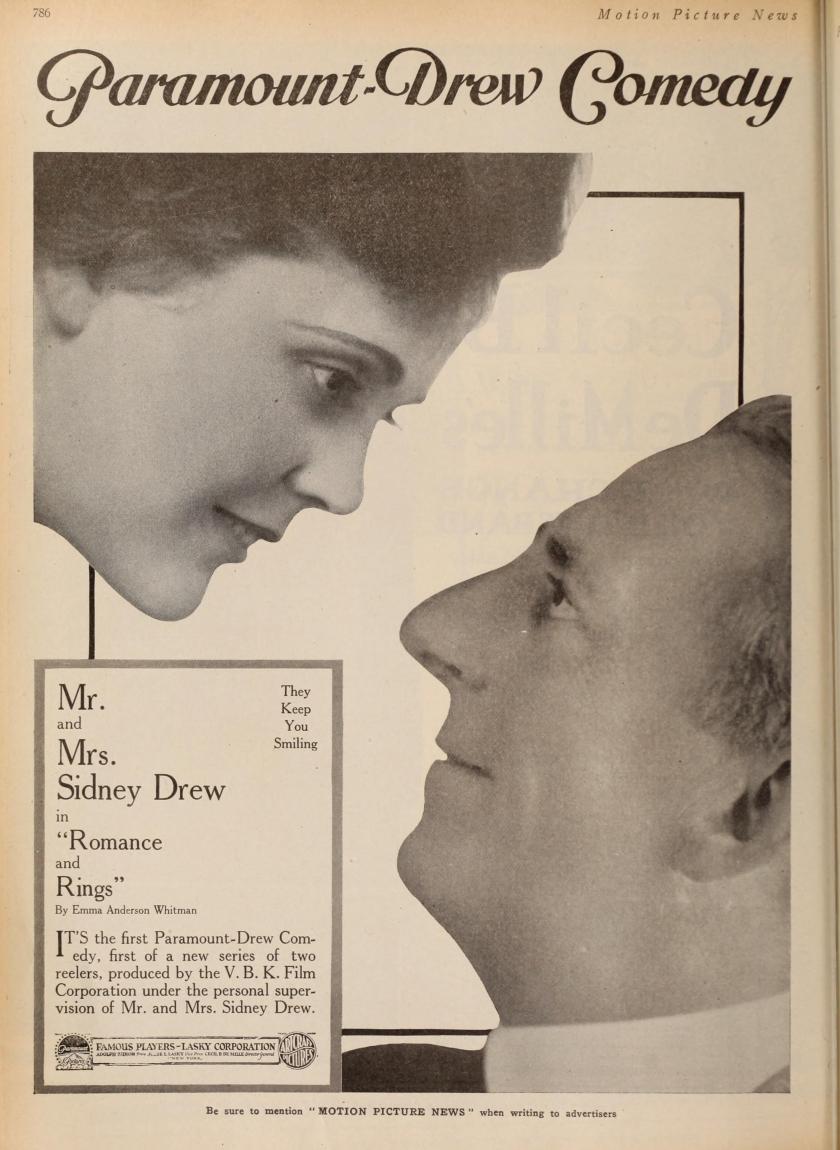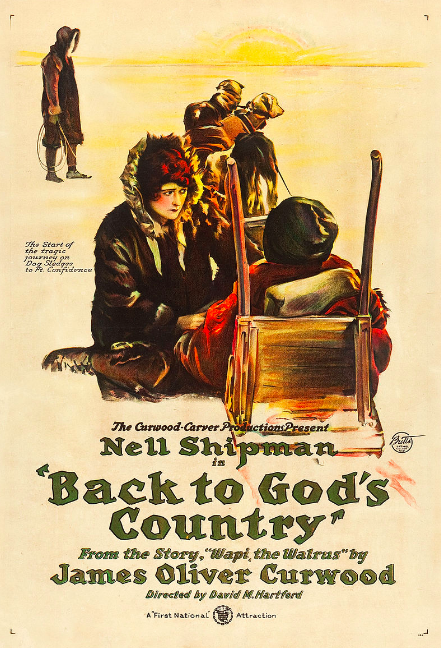
One hundred years ago this week, Grace Kingsley reported that the pictures were going to church:
Now that the Methodist-Episcopalian church has officially decided that there’s nothing intrinsically wrong about motion pictures, it does seem as if the last objection to the flickers had been removed. In fact, the breach between pictures and the church would seems to have been entirely healed, for when the church above mentioned gathers its delegates together in June at Columbus Ohio, motion pictures will be part of the program.
It seems a picture pageant is to be prepared, showing the hundreds of Hindus, Japanese and Chinese who are to be present at the meeting, and who will work in the interests of foreign missions. Just what other action will be taken by the meeting is not known, but it has been whispered that pictures of a suitable nature may later be adopted as a part of entertainments and lectures given in the Methodist church.

It seems it wasn’t all Methodists who objected to the pictures, it was mostly one in Los Angeles: Charles Edward Locke, pastor of the First Methodist Episcopal Church. He had given a fiery sermon about them on July 7th 1918. Kingsley misremembered it a bit, because he didn’t condemn all films. He conceded that motion pictures had great possibility for instruction, and “the desire for recreation and amusement is legitimate and within certain bounds be encouraged.” Why, he had even recommended films from the pulpit that would provide uplift. However, he had also “severely criticized and denounced the increasing tendency to prostitute the high art of the motion picture into an insidious debauchery of the young and old.” Furthermore, “pictures have never been so daring and prurient and salacious and indecent as they are today.” His knickers were in quite the twist.
It got even better. Knowing which side his bread was buttered on, Locke blamed filmmakers, saying “the producers and not the patrons are wholly responsible.” He told of “a gentleman who is fond of elevating pictures and who visits most of the motion-picture houses tells me that he is almost continuously offended by the inexcusable introduction of scenes which are utterly degrading and repulsive.” Poor man, it must have been exhausting to be continuously offended. How terrible that the big mean theater owners forced him to hand over his quarters and then marched him into such dens of inequity!
To solve the problem, Locke declared “a censorship should be established as will make it impossible for these despicable creatures to carry forward their schemes of moral degradation.” He asked his congregation to call on the Mayor and City Council for “immediate legislation that will raise the moral standard of motion pictures and that will prohibit the exhibition of flagrantly offensive films.”
There’s no evidence that anything came of this. The reports from Council meetings said that they was busy arguing over if their new blue laws that closed stores on Sundays should apply to drug stores too, and whether a new road should be built to the harbor. Los Angeles citizens were too busy worrying about the war to spend time on film censorship. The next Sunday, even Locke had forgotten about it, and he preached an equally fiery sermon against the Kaiser. But it seems to have stuck in Kingsley’s head, so she could be glad the Methodists gotten over their objections to the pictures.

The meeting that Kingsley mentioned was a very big deal indeed. Held June 20th to July 13th, the Centenary Celebration of American Methodist Missions attracted over 100,000 visitors to Columbus, Ohio where they walked through eight large pavilions displaying missionary work from around the world. It was a Methodist World’s Fair. They also had popular entertainment, including a Ferris wheel, a Wild West show, concerts by the Cincinnati Symphony, and a ten-story film screen, where they showed both ethnographic films about their missionary work, and movies from Hollywood. In 2012, Christopher Anderson published two books about it.

Kingsley had a cute story about D.W. Griffith’s newest protégé:
Carol Dempster, the lovely new Griffith star, who is playing the leading role in The Girl who Stayed at Home at Graumans, has a devoted and solicitous admirer in her small nephew, Dempster Glines. Dempster went to the show the other night and nearly broke it up. Whenever the bullying Germans grabbed Carol, he shouted aloud, “Quit that! You let my auntie alone!” And when the wicked German was finally shot, the youngster shouted, so his voice carried to the uttermost parts of the gallery, “Hooray! Give it to him! Give it to him good!”
I’m glad Carol Dempster had family who stood up for her: film fans haven’t always been kind to her memory. Dempster was 6 years old in 1919. He changed his name to James when he grew up, tried acting, worked as a shipping clerk and served in the National Guard during the Second World War.
Another young actress, Bessie Love, was looking forward to a notable achievement:
Little Bessie Love ought to be awarded the palm for thoroughness. What do you think? Little Bessie is to graduate from the Los Angeles High School in June!
You see Bessie quit school at the beginning of her senior year, just three years ago, to become a picture actress. And she worked so hard for a while that she had no time for school. Then she began to wish she had finished the isms and ologies she had forsaken, so she began to attend night school. And now her teachers do say that she has qualified herself to receive, with the graduating class which goes out into the cold world in June, a sheepskin duly equipped with the credentials which ought to bear on them, if they do not, the legend, “For a good little girl.”
Calling a 20-year-old woman a good little girl is awfully infantilizing, but that’s how she was sold in the ads for her films. Kingsley herself only got to complete one year of high school before she had to go to work as a stenographer.

Kingsley’s best line this week was in a review of All For A Kiss, the musical comedy at the Burbank Theater that she thought rivaled shows at New York’s Winter Garden. It actually had a plot, and:
It’s a cunningly devised plot, too—that is, I mean it is cunning devised so as to hang on it as many bathing suit scenes and tropical island costumes and hula dances and comic numbers by the three comedians as possible.
You really don’t need to know anything more about it: this entertainment was thoroughly free from any moral uplift. Rev. Locke probably didn’t attend.
***********
Here’s a digression from this week’s news that I stumbled on while researching Rev. Locke. In his anti-film sermon he mentioned one particularly evil example that
resulted in action looking toward a proper censorship by the City Council, but the purposes of their wise legislation were defeated by assurances from the large picture producers that if the whole matter were left to them the evil tendencies would be corrected. The Council was betrayed.
Of course I had to see what that was about. On December 21, 1917 Mayor Woodman had ordered Free and Equal to be suppressed because it was “immoral.” A delegation of 50 producers, distributors and exhibitors showed up at his office right after Christmas, denounced that exhibitor as a “wildcatter,” and begged for the whole industry to not be punished for one irresponsible person. The said they’d already started a committee of their own, and would do the censoring themselves. The Mayor promised to wait two weeks before he did anything, and it seems that everybody promptly forgot about the whole thing, except for Rev. Locke.

Remarkably, it wasn’t sex or violence that they were censoring; it was a film about intermarriage between black and white people. (Once again, the past is a foreign country!) Now lost, Free and Equal told the story of a white judge who believes there will be equality if black and white people can marry – until his daughter marries a mixed-race man who is committing bigamy. Then the husband murders another young woman as he was getting ready to rape her, mostly because they’re dealing in hypersexual racist stereotypes but also partly because it was a Thomas Ince melodrama from 1917. He ends up in prison and the judge quits believing in equality. It was certainly a reprehensible film, but the NAACP dealt with it in a much smarter way when it finally did get shown, as the anonymous AFI Catalog writer reported:
According to information in the NAACP Papers at the Library of Congress, the National Office of the NAACP sent an official to the opening on 19 April 1925, after having received over a period of a few months “more or less mysterious intimations” about the film “which was characterized as being much worse than The Birth of a Nation.” The official judged the film to be “very offensive,” and surmising that “the intimations sent us were a bid for publicity,” the NAACP decided to take no action to protest the film. After a week in New York, it was withdrawn.
“Film Men Ask To Aid Mayor,” Los Angeles Times, December 27, 1917.
“Mayor Orders a Film Suppressed,” Los Angeles Times, December 22, 1917.
“Must Prohibit Vicious Films,” Los Angeles Times, July 8, 1918.



























